Songjianghe biotite monzonitic granite zircon U-Pb geochronology and geochemical significance
2016-10-31WANGGuozhiLIBilePENGBoNINGChuanqiandYANGWenlong
WANG Guozhi, LI Bile, PENG Bo, NING Chuanqi and YANG Wenlong
College of Earth Sciences, Jilin University, Changchun 130061, China
10.3969/j.issn.1673-9736.2016.03.02
Songjianghe biotite monzonitic granite zircon U-Pb geochronology and geochemical significance
WANG Guozhi, LI Bile, PENG Bo, NING Chuanqi and YANG Wenlong
CollegeofEarthSciences,JilinUniversity,Changchun130061,China
The authors studied geochronology and geochemical data of the Songjianghe biotite monzogranite in the southern Zhangguangcai Range in order to determine its formation age, magma source, and tectonic environment. The results indicate that the Songjianghe biotite monzogranite was formed in the Middle Jurassic with an age of 168.2±2.0 Ma (MSWD=0.93). The monzogranite was characterized by high alkali and low CaO and MgO, belonging to high-potassium calc-alkaline, metaluminous I-type granite. The rock is enriched in large ion lithophile elements such as Rb, Ba, and K and strongly depleted high field strength elements such as P, Ti, Nb, and Ta. It is concluded that the Songjianghe biotite monzogranite was derived from partial melting of amphibolite facies metamorphism mafic lower-crust and its formation was controlled by the Pacific Plate subduction.
Songjianghe; biotite adamellite; geochemistry; zircon U-Pb age; Pacific Plate subduction
1 Introduction
Granites, as the most significant components of the continental crust, have remained stable and above mean sea level for more than a billion years (Petfordetal., 2000). They are the manifestation of heat and/or mass transmission between the mantle and crust and are largely the production of tectonic events. They record valuable messages of the tectonic evolution of the Earth. Thus, geochemical and geochronological studies on granites are useful in aiding our understanding of regional tectonic evolution (Wuetal., 2003; 2011). In addition, magmatism is always accompanied by mineralization, meaning studies on granites can also help clarify regional metallogenic times and patterns (Xuetal., 2013).
Northeast China is located at the eastern segment of the Central Asian orogenic belt (Jahnetal., 2000) and has huge volumes of granitic intrusions. These granites are characterized as being enriched in radioactive Nd, which indicates that they contain a large proportion of juvenile crustal material, recording significant continental growth during the Phanerozoic (Jahnetal., 2000). Two stages of tectonic evolution occurred in NE China. During the Paleozoic, tectonic evolution was controlled by the closure of the Paleo-Asian Ocean and the collision between the Siberia and the North China Craton. Since the Jurassic, subduction of the Pacific Plate has dominated the magma-tectonic activities in this area (Wuetal., 2011). The Zhangguangcai Range is strongly affected by these two tectonic activities, and several types of granites have developed wildly since the Paleozoic (Wuetal., 2011). Hence, precise geochemical and geochronological studies in these granites are helpful in determining clearly the tectonic evolution of NE China since the Paleozoic. Through geochemical and geochronological studies of the granite mass located near the Songjianghe gold ore (called Songjianghe monzonitic granite in this paper), we can constrain the tectonic setting for the formation of the southern Zhangguangcai Range.
2 Geological background and lithological characteristics
NE China is composed of several micro-continental blocks and/or terranes. From west to east (Fig.1), there are the Erguna Massif, Songliao Xing’an Massif, Songliao Basin, Jiamusi Massif, Nadahada Terrane, and Xingkai Massif. The research area is located in the southern Zhangguangcai Range, the Songliao Basin. Massive granitoids were developed in this area in the Jurassic. Low metamorphic rocks, including low metamorphic intermediate-acidic volcanic rocks, granulite, phyllite, slate, metasandstone, and marble, are found in the Lower Paleozoic. Intermediate-acidic volcanic rocks, epicontinental clastic sedimentary rocks, and carbonate rocks are appeared in the Upper Paleozoic. The Mesozoic strata are composed of intermediate-acid volcanic rocks and clastic sedimentary rocks.
The Songjianghe monzonitic granite is located westward of the Songjianghe gold ore (sampling location: 127°49′46″, 42°48′8″) (Fig.2).
The main strata exposed are Proterozoic metamor-phic rocks, including amphibolitic mylonite schist (Pt2s3), amphibolitic schist and biotite amphibolitic mylonite schist (Pt2s2), and amphibolitic schist and amphibolitic mylonite schist with tremolite marble lens (Pt2s1). The main rock mass in the area is composed of biotite plagiogranite (T1h), the Wudaoliuhe Unit (J2w), and pyroxene hornblendite (υ). The sample location is within the Wudaoliuhe Unit(Fig.2).
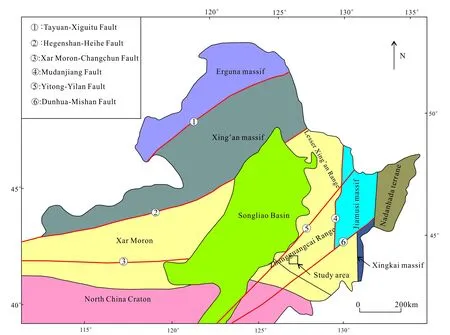
Fig.1 Regional structural map of Songjianghe deposit
The Songjianghe monzonitic granite is mainly composed of a biotite monzonitic granite with a mineral composition of plagioclase (35%), orthoclase(35%), quartz (20%), biotite (10%)(Fig.3). The biotites are lamellar, with an irregular shape and cleavage. They are ~1 mm in size. The feldspars are tabular with a fine crystal shape, twinned crystals are common. Their sizes are above 2 mm. The quartz crystals are irregular filled with a size above 1 mm. Accessory minerals such as zircon, apatite and titanite, can be found in the samples.
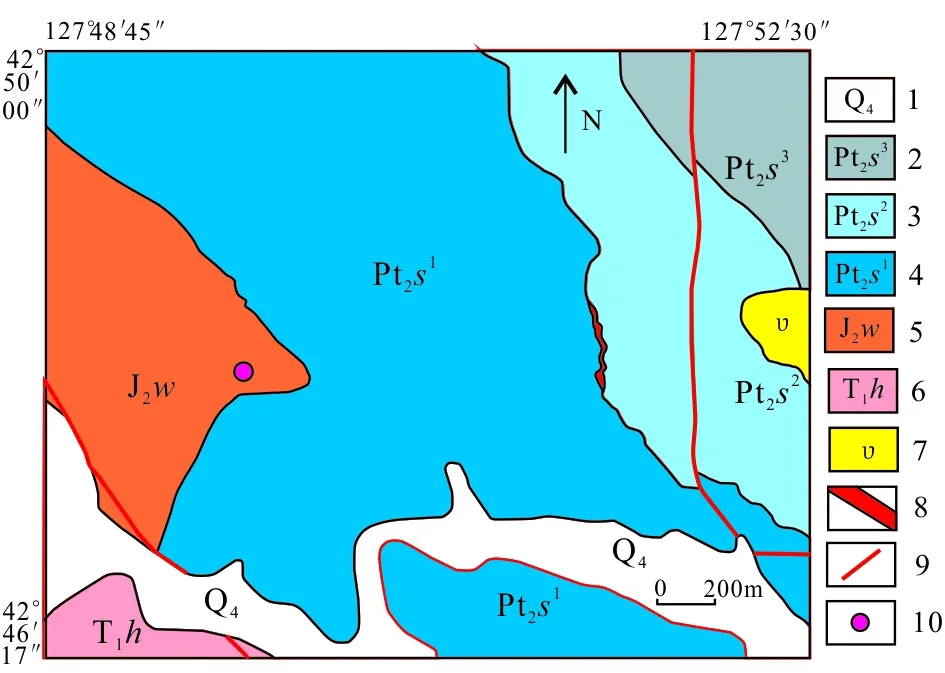
1. Quaternary; 2. upper Seluohe Group: amphibolitic mylonite sheet, hornblende schist, green clay schist; 3. middle Seluohe Group: biotite plagioclase mylonite schist, biotite schist; 4.lower Seluohe Group: amphibolitic mylonite schist, amphibolitic felsic mylonite with marble lenses; 5. Wudaoliuhe unit: moyites; 6. Huangniling unit: plagioclase granite and granodiorite; 7. pyroxene amphibolite; 8. Au ore body; 9. faults; 10. sampling point.Fig.2 Geological map for Songjianghe adamellite mine
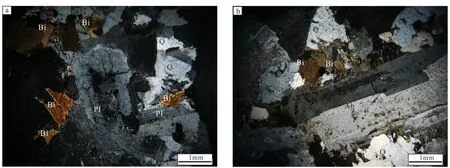
Bi: biotite; Ab: K-feldspar; Pl: plagioclase; Q: quartz.Fig.3 Microscopic photos for Songjianghe adamellite
3 Analysis method
3.1LA-ICP-MS zircon U-Pb dating
Zircons were separated from the Songjianghe monzonitic granite samples used standard density and magnetic separation techniques in the Laboratory of the Regional Geological Survey of Heibei Province, China. Fine grains of zircon with well crystalline form were handpicked under binocular and mounted in an epoxy resin disc, and then polished and coated with carbon. Zircons were pictured with transmitted and reflected light micrographs as well as cathodoluminescence (CL) images to reveal their external and internal structures and select the best locations for U-Pb dating. All the procedures were conducted in Beijing Research Institute of Uranium Geology. Zircon U-Pb dating and trace elements analysis were carried out in State Key Laboratory of Geological Processes and Mineral Resources, China University of Geoscience (Wuhan). A spot diameter of 32 μm were used during analysis. U-Th-Pb ratios and absolute abundances were determined by reference to multiple measurements of the Zircon 91500 and NIST SRM610 glass. Detailed procedures were refered the way of Yuanetal. (2004). Common Pb was corrected following Andersen (2002). The isotope ratios and contents were calculated using the ICP-MS-DataCal Program (Liuetal., 2008). The isotopic data were processed using the Isoplot program (Ludwig, 1991).
3.2Major and trace elements analysis
Major elements and trace elements analyses were conducted in National Research Centre for Geoanalysis, Chinese Academy of Geological Sciences. Major element data were determined using X-ray fluorescence (XRF) and were measured alongside the Chinese standard GB/T14506.28-2010. Analytical uncertainty is generally within 5%. Loss-on-ignition (LOI) contents of the samples were measured in a Muffle furnace after heating at 900℃ for 3 h. Whole rock powders with HF and HNO3mixtures were dissolved in Teflon bombs under high pressure for 48 h and dilute for trace elements analysis. Analysis was done using Anglient 7500 ICP-MS and Rh was used as an internal standard to monitor signal drift during counting. The Chinese National standards GSR-3 was used for analytical quality control.
4 Analysis results
4.1Zircon U-Pb geochronology
Thirty zircon grains from the Songjianghe monzonitic granite are used to perform U-Pb dating. The zircon U-Pb analytical data and calculation results are listed in Table 1. All of the zircons are euhedral or subhedral with a granular or prismatic shape and a size between 50 μm and 200 μm. Cathodoluminescence (CL) images demonstrate that all of these zircons have clear oscillatory zoning. Zircon Th/U ratios are between 0.96 and 1.64, indicating their magmatic origin. The results of the thirty analyses form a tight cluster showing a weighted mean age of 168±2.0 Ma (MSWD=0.93) (Fig.5), indicating the Songjianghe monzonitic granite formed in the Middle Jurassic.
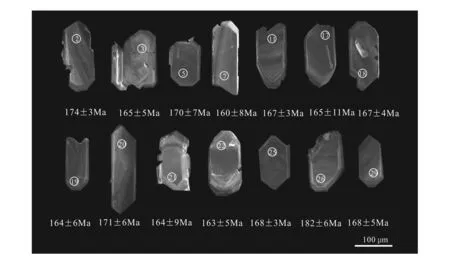
Fig.4 CL image of zircon from granite in Songjianghe
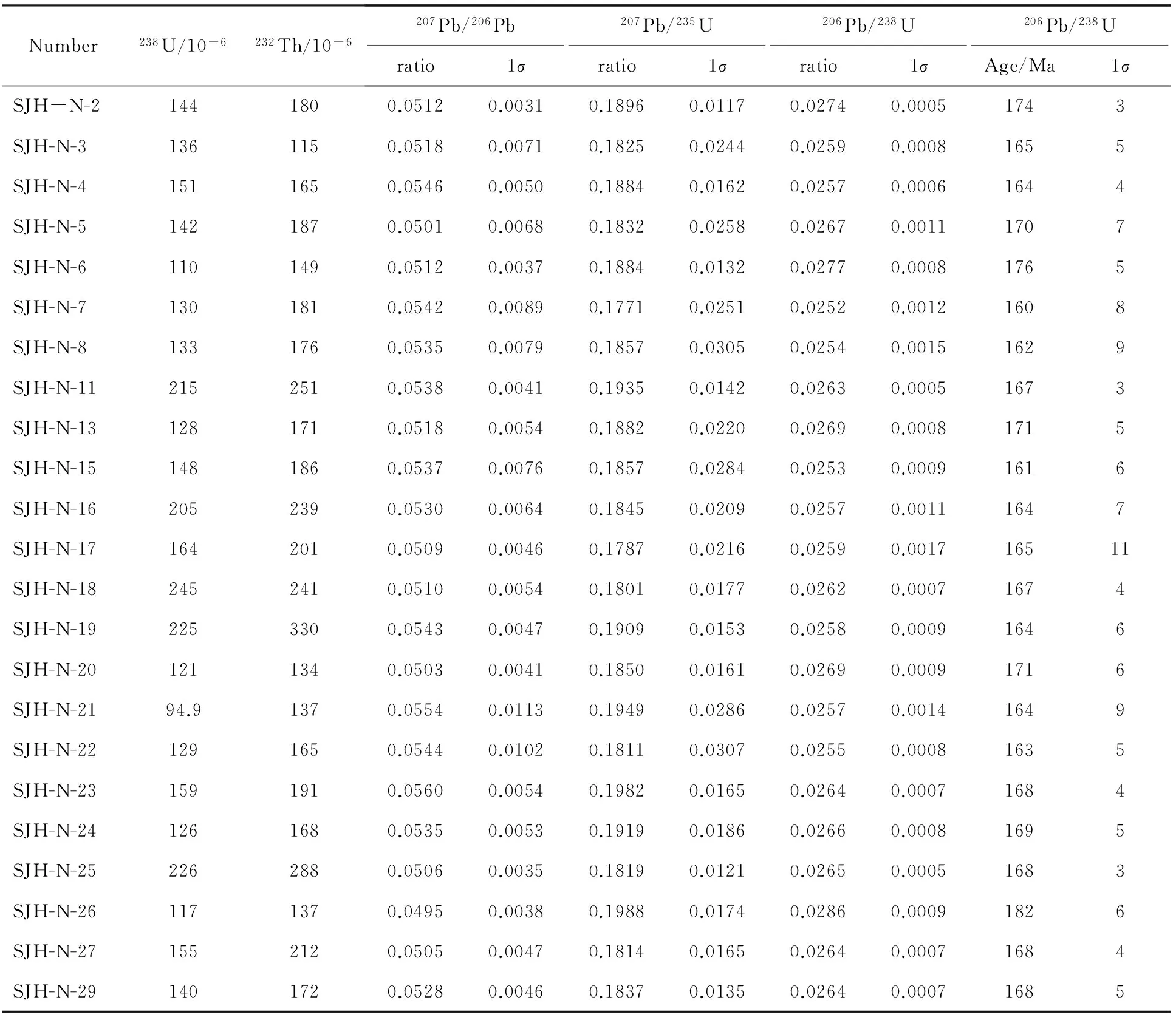
Table 1 LA-ICP-MS zircon U-Pb isotopic dating of Songjianghe granite
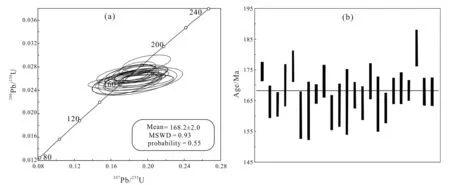
Fig.5 U-Pb Concordia diagram (a) and weighted average age diagram (b) for zircons in Songjianghe granite
4.2Major elements
Major and trace element data for the Songjianghe monzonitic granite are shown in Table 2. The ignition loss (LOI) of the samples are low (0.86%-1.24%), which is consistent with their relative freshness under microscope observation. The samples have relative homogeneous major element compositions withω(SiO2) between 66.91% and 67.91%. They are characterized by high aluminum oxide (Al2O3, 15.35%-15.71%), high total alkali (Na2O+K2O, 8.33%-8.55%), low calcium oxide (CaO, 2.01%-2.38%), and low magnesium oxide (MgO, 0.81%-0.91%) in contents. They also have relative consistent TFeO/(TFeO+MgO) ratios between 0.787 and 0.799. In SiO2-(Na2O+K2O) diagram, all the samples are within the alkali granite field (Fig.6). All of the samples are classified as a high-K calc-alkaline series on the SiO2-K2O diagram (Fig.7a). The samples
have low A/NCK (0.94-1.01) and A/NK (1.31-1.34) ratios and most of the samples are metaluminous according to the A/NCK-A/NK diagram (Fig.7b).

Table 2 Major elements values (wB/%) of Songjianghe monzonitic granite
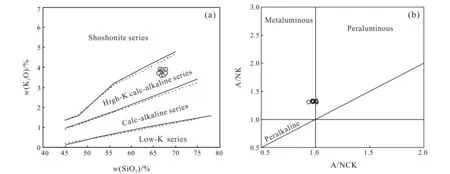
Fig.7 Diagrams of SiO2-K2O (a) and A / NCK-A/NK (b) of Songjianghe monzonitic granite

Table 3 Trace elements (wB/10-6) values of Songjianghe monzonitic granite
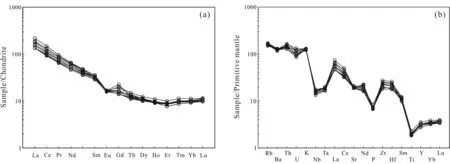
Fig.8 Chondrite standardized chart (a) and trace element spider diagram (b) for Songjianghe granite
4.3Rare earth elements and trace elements
The Songjianghe granites have high total concentrations of rare earth elements (REEs) between 1.48×10-6and 216×10-6. In the chondrite normalized REE diagram (Fig.8), the samples show coherent, subparallel REE patterns with significant enrichment in LREE relative to HREE ((La/Yb)N=13.83-20.31), but MREE are not significantly enriched relative to HREE ((Gd/Yb)N=1.39-1.59), and a trough occurred in Er. The samples also show remarkable Eu negative anomaly with δEu (2EuN/(SmN+GdN)) between 0.58 and 0.78.
In the primitive mantle normalized spider diagrams for the Songjianghe granites, these samples show a pattern similar to the crust with enrichments in large ion lithosphere elements (LILEs, e.g. Rb, Ba) and depleted in high field strength elements (HFSEs) such as Nb and Ti. In addition, these samples show a negative anomaly for Sr and P.
5 Discussion
5.1Petrogenesis and magma source
Divergences exist in the petrogenesis of granites. They may form by ① the fractionation of basaltic magma (Turneretal., 1992; Hanetal., 1997); ② mixing mantle with crust derived magmas (Yangetal., 2006; Jahnetal., 2000); or ③ partial melting of crustal materials (Annenetal., 2006; Hildreth & Mtoorbath, 1988; Wuetal., 2003). The Songjianghe monzonitic granite has homogenous compositions, indicating that fractional crystallization does not control the chemical composition variations. In addition, synchronous basaltic magma activities are not reported in the Songjianghe area. Therefore, we infer that they are not the product of basaltic magma fractionation. Huge density and viscosity differences existed in basaltic and acid magmas, implies that if the granites are formed by magma mixing, basic rock enclaves were found in the granites (Yangetal., 2006) and disequilibrium structures exist in the minerals (Kentetal., 2010). None of these phenomena exist in the Songjianghe granites. Thus, magma mixing does not play a key role in the formation of the Songjianghe granites.
The Songjianghe granites are produced by the partial melting of crustal materials. These granites have relative homogenous major and trace elements compositions within error. This indicates that the whole rock composition represents the primary magma composition and can be used to discuss its petrogenesis and source characteristics directly. They contain biotite as a mineral phase rather than Al-saturation minerals phases. In addition, they have low A/NCK values (0.96-1.02) compared to S-type granites (A/CNK>1, Chappell, 1999). In the SiO2-TFeO/ (TFeO+MgO) diagram (Fig.9), the Songjianghe granites have lower TFeO/(TFeO+MgO) ratios than A-type granites and are similar to typical I-type granites (Colorado granites). This characteristic can be further proved by the (Zr+Nb+Ce+Y) vs. TFeO/MgO and (Na2O+K2O)/CaO diagrams (Fig.10). Most features of the Songjianghe granites are shown within the area of unfractionated I-/S-/M- type granites and are different from A-type granites.
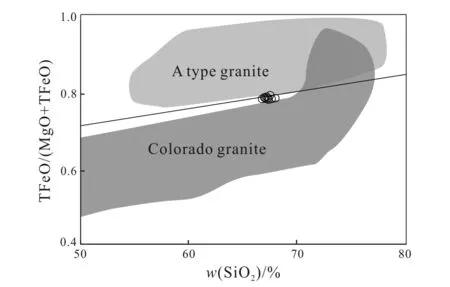
Fig.9 Diagram of SiO2-TFeO/(TFeO+MgO) for Songjianghe granite
Zircon saturation temperatures in the Songjianghe granites further prove the above conclusions. They are between 803 and 837℃ with an average temperature of 819 ℃. These values are lower than A-type granite temperatures and are close to typical fractionated I-type granite temperatures. Thus, the Songjianghe monzonitic granite is unfractionated I-type granites and are formed by the partial melting of lower crustal mafic rocks.
Trace elements and REEs can help clarify the source lithology of the Songjianghe granite. They clearly show Sr and Eu negative anomalies, which differ from the lower crust that ave Sr and Eu positive anomalies. This indicates that plagioclase is residual in their magma source. In addition, MREEs have the highest partition of hornblende (Sisson, 1994). Thus, the slight depletion of MREEs in the Songjianghe granites implies that hornblende is a residue phase. Apatite residue in the source may explain thereason for the relative depletion of P. Therefore, the Songjianghe granite may be formed by partial melting of amphibolite facies metamorphic mafic rocks.
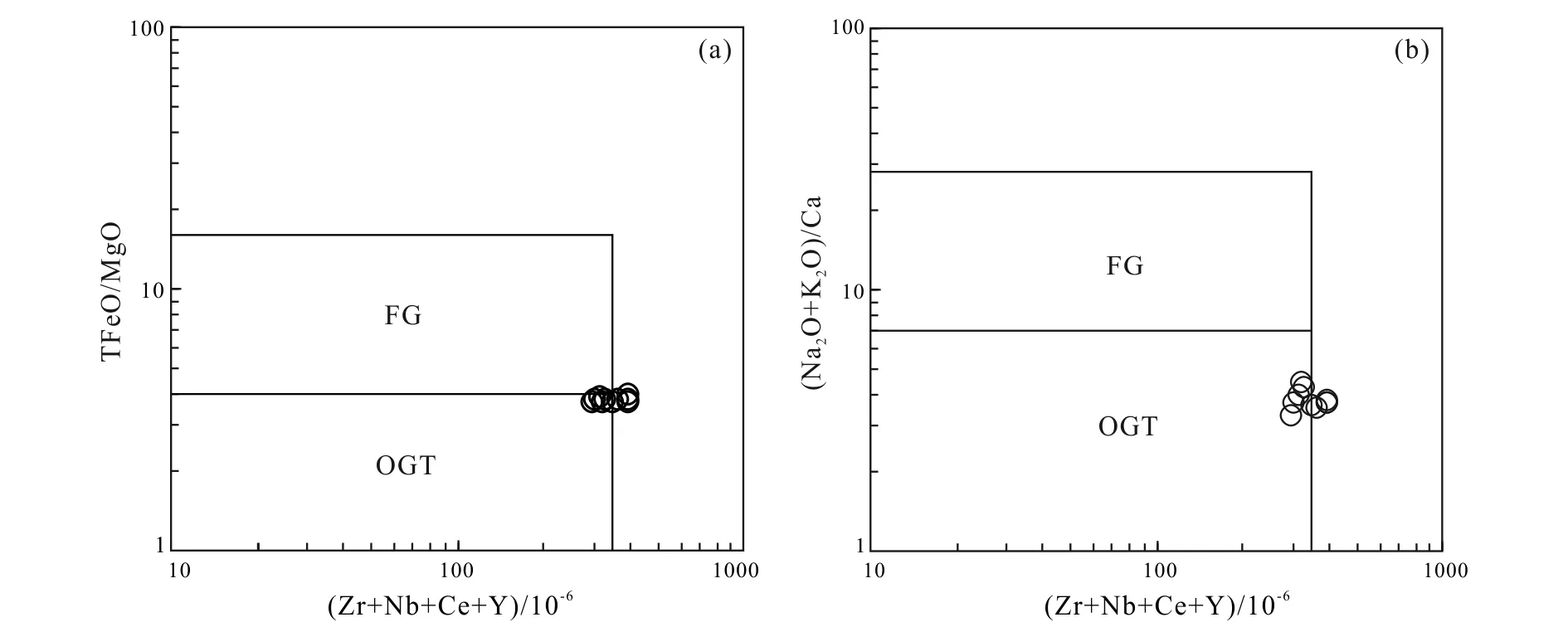
Fig.10 Diagrams of (Zr+Nb+Ce+Y)- FeOT/MgO (a) and (Na2O+K2O)/CaO (b) for Songjianghe granite
5.2Tectonic settings
Due to the different environments in which granites form, the granites often show different geochemical characteristics and can be used to distinguish tectonic environments from their differing chemical compositions. In (Yb+Nb)-Rb and Yb-Ta discriminate diagrams (Fig.11a, b), all of the samples fall within the volcanic arc granite (VAG) field. The characters are supported by other granite masses found in this area. Studies on A-type granites indicate that full closure of the Paleo-Asian Ocean occurred in the Triassic, marking the end of the evolution of the Paleo-Asian Ocean tectonic domain. Xinkailing granites occurred in northwestern Zhangguangcai Range, were formed in 181-171 Ma and were controlled by subduction of the Pacific Plate. The study of Jurassic granites in the Zhangguangcai Range by Wuetal. (2011) indicates most of these granites are I-type with formation ages between 200 and 147 Ma. In addition, a geochronological study on the Tianqiaogang alkali feldspar granite indicates the collision between the Jiamusi Massif and the Songliao Terrane occurred in the Early Jurassic(Lietal., 2016). All of these magma-tectonic events indicate that huge acidic magma activities and continental growth were caused by subduction of the Pacific Ocean Plate in the Jurassic.
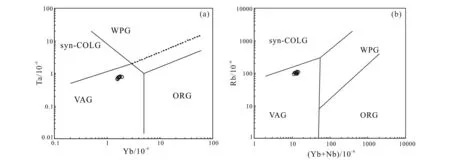
Fig.11 Diagrams of Yb-Ta (a) and (Yb + Nb) - Rb (b) for Songjianghe granite
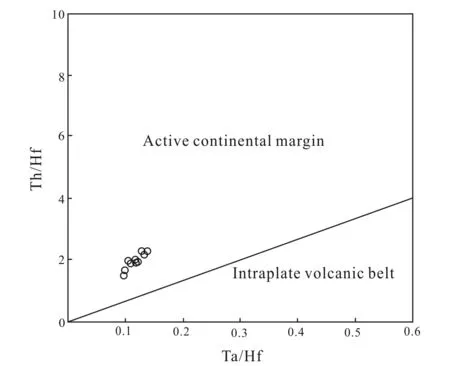
Fig.12 Diagram of Th/Hf-Ta/Hf for Songjianghe granite
Studies on the Early-Middle Jurassic porphyritic typeand skarn type deposits suggest calc-alkaline or high-K calc-alkaline intrusions with active continental margin magmatic rock characteristics are closely associated with mineralization. These deposits and related intrusions are arc-shaped and closely related in space, showing the characteristics of active continental margin mineralization. In the Th/Hf-Ta/Hf diagram (Fig.12), the Songjianghe granites are shown within the field of an active continental margin and thus demonstrate active continental margin affinity. The Songjiaohe granites, combined with Early-Middle Jurassic high-K calc-alkaline granites, are composed of a nearly north-south (N-S) trending magmatic-mineralization belt with similar rock-forming and metallogenic age, which should be the production of Pacific Plate subduction. The subduction of the Pacific Plate can cause rejuvenation of ancient suture zones and lead to large amounts of tectonic-magmatic activity and mineralization. Thus, the formation of the Songjianghe monzonitic granite is controlled by Pacific Plate subduction in the Jurassic.
6 Conclusions
The Songjianghe monzonitic granite shows a formation time of 168.2±2.0 Ma, which belongs to I-type granite. The rock was formed by partial melting of amphibolite facies metamorphic mafic lower crust, was indicating that the Songjianghe area was an active continental margin caused by the subduction of the Pacific Plate.
Andersen T. 2002. Correction of common lead in U-Pb analyses that do not report 204 Pb.ChemicalGeology, 192(1): 59-79.
Annen C, Blundy J D, Sparks R S J. 2006. The genesis of intermediate and silicic magmas in deep crustal hot zones.JournalofPetrology, 47(3): 505-539.
Chappell B W. 1999. Aluminium saturation in I- and S-type granites and the characterization of fractionated haplogranites.Lithos, 46(3): 535-551.
Han B, Wang S, Jahn B,etal. 1997. Depleted-mantle source for the Ulungur River A-type granites from North Xinjiang, China: geochemistry and Nd-Sr isotopic evidence, and implications for Phanerozoic crustal growth.ChemicalGeology, 138(3): 135-159.
Hildreth W, Moorbath S. 1988. Crustal contributions to arc magmatism in the Andes of central Chile.ContributionstoMineralogyandPetrology, 98(4): 455-489.
Jahn B, Wu F, Chen B. 2000. Granitoids of the Central Asian Orogenic Belt and continental growth in the Phanerozoic.TransactionsoftheRoyalSocietyofEdinburgh:EarthSciences, 91(1/2): 181-193.
Kent A J R, Darr C, Koleszar A M,etal. 2010. Preferential eruption of andesitic magmas through recharge filtering.NatureGeoscience, 3(9): 631-636.
Li B L, Sun Y G, Chen G J,etal. 2016. Zircon U-Pb geochronology, geochemistry and Hf isotopic composition and its geological implication of the fine-grained syenogranite in Dong’an goldfield from the Lesser Xing’an Mountains.EarthScience, 41(1): 1-16. (in Chinese with English abstract)
Liu Y, Hu Z, Gao S,etal. 2008. In situ analysis of major and trace elements of anhydrous minerals by LA-ICP-MS without applying an internal standard.ChemicalGeology, 257(1): 34-43.
Ludwig K R. 1991. ISOPLOT; a plotting and regression program for radiogenic-isotope data; version 2.53: Report 91-445. US Geological Survey. https://pubs.er.usgs.gov/publication/ 91445
Petford N, Cruden A R, McCaffrey K J W,etal. 2000. Granite magma formation, transport and emplacement in the Earth’s crust.Nature, 408: 669-673.
Sisson T W. 1994. Hornblende-melt trace-element partitioning measured by ion microprobe.ChemicalGeology, 117(1): 331-344.
Turner S P, Foden J D, Morrison R S. 1992. Derivation of some A-type magmas by fractionation of basaltic magma: an example from the Padthaway Ridge, South Australia.Lithos, 28(2): 151-179.
Wu F Y, Sun D Y, Ge W C,etal. 2011. Geochronology of the Phanerozoic granitoids in northeastern China.JournalofAsianEarthSciences, 41(1): 1-30.
Wu F, Jahn B, Wilde S A,etal. 2003. Highly fractionated I-type granites in NE China (I): geochronology and petrogenesis.Lithos, 66(3): 241-273.
Xu W L, Wang F, Pei F P,etal. 2013. Mesozoic tectonic regimes and regional ore-forming background in NE China: Constraints from spatial and temporal variations of Mesozoic volcanic rock associations.ActaPetrologicaSinica, 29(2): 339-353. (in Chinese with English abstract)
Yang J H, Wu F Y, Chung S L,etal. 2006. A hybrid origin for the Qianshan A-type granite, northeast China: geochemical and Sr-Nd-Hf isotopic evidence.Lithos, 89(1): 89-106.
Yuan H, Gao S, Liu X,etal. 2004. Accurate U-Pb age and trace element determinations of zircon by laser ablation-inductively coupled plasma-mass spectrometry.GeostandardsandGeoanalyticalResearch, 28(3): 353-370.
4 April 2016, accepted 6 May 2016
Supported by project of National Natural Science Foundation of China (No. 41272095)
Article ID: 1673-9736(2016)03-0133-11
杂志排行
Global Geology的其它文章
- Experimental study on simulation test instrument and its penetration performance of soil infiltration clogging
- Experimental study of seepage characteristics of single rock fracture based on stress states and stress history
- Geochemical characteristics and petrogenesis of volcanic rocks from Baiyingaolao Formation in northeastern Hailar Basin
- Geochronology, geochemistry and Hf isotope of monzogranite in Niubiziliang of Qinghai
- Mechanism of spatial emplacement of Shanhou gold ore body in Laixi of Shandong and its prospecting significance
- Accumulation conditions of outside source heavy oil in Nepa-Botuoba Sub-basin, Russia and prediction of distribution
